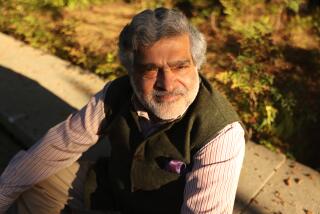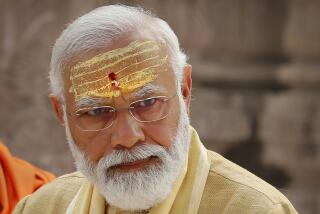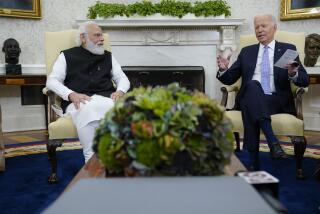Transformation of a Man Into a Leader of India’s Masses : NEHRU: A Tryst With Destiny by Stanley Wolpert; New York University Press $35, 546 pages
- Share via
“Galbraith, I’m the last English ruler of India,” Prime Minister Jawaharlal Nehru wryly told the American ambassador.
Ruler he certainly was, with more power than any British viceroy. English in part he certainly was, with his Harrow and Cambridge education and accent to match. The great love of his life was English too, Edwina Mountbatten, wife of the complaisant last viceroy.
For the record:
12:00 a.m. Oct. 21, 1996 For the Record
Los Angeles Times Monday October 21, 1996 Home Edition Life & Style Part E Page 3 View Desk 1 inches; 21 words Type of Material: Correction
Book Review--The publisher of “Nehru: A Tryst With Destiny” by Stanley Wolpert, reviewed in Life & Style on Friday, Oct. 11, is Oxford University Press.
But he could have been only Indian, too, a “Kashmiri prince,” Stanley Wolpert aptly calls him.
In this book UCLA historian Wolpert, author of “Jinnah of Pakistan,” “Zulfi Bhutto of Pakistan” and “A New History of India,” attempts to explain the complex character of this brilliant, charismatic and introspective man who led India’s independence movement, became its first prime minister and founded the Nehru/Gandhi political dynasty.
Wolpert pays a lot of attention to Nehru’s childhood and youth, looking for clues to his later drive and ambition. The author seems to have found one: a fierce competition with the father he loved but eventually left behind politically. His father, Motilal, the richest lawyer in India, was the moderate in independence politics; the younger Nehru was the radical.
The father-son pattern was later repeated with Mahatma Gandhi. Both Nehrus early came under Gandhi’s spell, but years later Jawaharlal struck out on his own independent course.
Wolpert draws a nice picture of the transformation of Nehru from slightly bored young lawyer into the orator and figure who could move and lead the Indian masses.
In the spring of 1919 British troops massacred 400 Indians protesting for independence in Amritsar, the Punjab’s Sikh capital, making Amritsar “the cradle of India’s nationhood,” as Wolpert says.
In the ensuing protest campaigns, Nehru joined Gandhi and the two visited some of India’s villages.
Wolpert says that Nehru’s “awakening to the plight of India’s peasant population . . . imprinted his mind and heart with the power of a sudden religious conversion.” His new passion stayed with him all his life.
Relying heavily on Nehru’s own diary and other writings and interviews with family and friends, Wolpert’s portrait of Nehru from his “conversion” to independence in August 1947, is full and steady.
Nehru’s vexation with the politics of the independence movement is skillfully drawn, so that you understand when Nehru finds confinement in a British jail a restful experience. Nehru spent 10 years in all in jail on charges of sedition for advocating Indian independence and resistance to British rule. It was in jail that he wrote his books.
Wolpert usefully quotes at length from a curious document Nehru wrote about himself in 1937 and published under a pseudonym, though the author’s identity soon became known. The article discusses the character of “Jawaharlal”:
Jawaharlal “has all the makings of a dictator in him--vast popularity, a strong will . . . energy, pride . . . intolerance for others and certain contempt for the weak and the inefficient . . .
”. . . Is it not possible that Jawaharlal might fancy himself as a Caesar?”
*
Wolpert argues that in fact this is what happened, that as prime minister Nehru was a “benevolent despot.” And he makes the point that Nehru’s commitment to socialism foreclosed India from the kind of economic progress that a market economy would have produced. Wolpert quotes one of Nehru’s sisters as saying that her brother was a “Utopian Marxist until the day he died.”
Such an outlook was quite ordinary for the time, for Nehru appears as very much a modern man of the 19th century. He called himself secular and said he believed in science, and what was socialism but the result of a scientific look at economics?
Wolpert tells a good tale as the march toward independence quickens. The chapter on the terrible communal riots surrounding the partition of the subcontinent into India and Pakistan is appropriately grim. He also gives us a detailed picture of Nehru’s driven and unhappy heir, his daughter Indira.
But when Nehru becomes prime minister, Wolpert seems to lose interest. Only the last 105 pages are devoted to the 16 years of his tenure as prime minister, and the story becomes a jumble. The treatment of the invasion of Goa, for example, reads as if it was hurriedly written.
Yet the first four-fifths of the book, though marred by amateurish attempts at psychoanalysis, stand as a strong portrait of one of the most influential, and most interesting, leaders of the 20th century.
More to Read
Sign up for Essential California
The most important California stories and recommendations in your inbox every morning.
You may occasionally receive promotional content from the Los Angeles Times.













